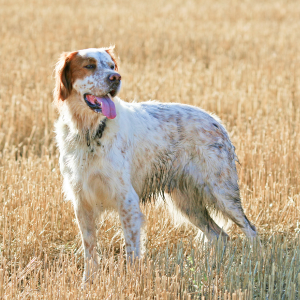
Llewellin Setter
The Llewellin Setter is an excellent hunting dog with a strong nose and a lovable personality. And with their beautiful ticked coats, they're sure to turn heads on your daily walks.
Interested in discovering if your dog is a Llewellin Setter?
Check out Wisdom Panel's DNA tests.

Llewellin Setter Traits
General Appearance
Llewellin Setters are medium-sized dogs with athletic bodies. Their movement is effortless and energetic.
Coat and Coloring
Llewellins have medium-length soft feathered coats. They come in black, white and tan; black and white; lemon and white; orange and white; liver and white; blue, lemon, orange, or liver belton; and solid white. Pups are born without any ticking or belton coloring, and develop those markings as they age.
Distinctive Physical Traits
Llewellins are known for carrying their tails high to be seen in tall grass and brush. They have moderately-sized ears and a lighter build compared to their show cousins.
Llewellin Setter Temperament
Llewellins are hard-working, energetic pups. They have the stamina for long hunts and enjoy an evening curled up by the fire after a fun-filled day. This people-oriented breed is loyal and affectionate. And when properly exercised, they have a calm nature that makes them well-suited for families with kids.


Llewellin Setter History
The Llewellin Setter dates back to the mid-1800s, and to this day it is a subject of much debate whether the Llewellin is a specific working line of English setter, or its own breed.
The Llewellin is named for its founder, the Welsh gentleman Richard Purcell Llewellin, who sought to develop a superior hunting dog, derived from Edward Laverack’s popularized English setters. While Laverack’s lines are now most closely associated with the show or “bench” lines of the English setter we know today, Llewellin sought to create an exclusively field-style or working bird dog without any physical exaggerations. Because the Llewellin is defined by its working ability, not appearance, it is often a little smaller than the show style English Setter, with a shorter coat and smaller ears, but with greater stamina and the ability to handle warmer temperatures.
Many gundog enthusiasts describe the Llewellin as the premier quail hunting breed, and to this day, you will find show-style English setters referred to as Laveracks and working English setters as field setters or Llewellins. The reality is they are both English setters.
Llewellin Setter Care
Nutrition
The Llewellin Setter does well on high-quality dog food formulated for their age, size, and activity level. To help them maintain a healthy weight, measure their meals to avoid overfeeding and keep treats to 10% or less of their daily calories.
Because some have deep chests, they may be at greater risk of bloat (also known as twisted stomach). To help prevent bloat, break their food up into several meals a day and use a food bowl designed to slow their eating. Avoid feeding them immediately after vigorous activity, and wait at least an hour after eating before allowing them to run or exercise. These are just a few ways you can help prevent this life-threatening condition. A veterinarian is the best resource for other recommendations—including surgical options—for preventing bloat.
Grooming
This breed's medium-length coat requires daily brushing to remove loose fur and keep it free from tangles. Their pendant ears may put them at greater risk for ear infections. Be sure to check their ears regularly for debris or wax build-up and clean them as needed. Additionally, regular nail trims and dental care should be part of their grooming routine.
Exercise
This high-energy dog needs plenty of daily exercise. To help them stay healthy, plan to walk them briskly for at least an hour a day. Other activities to help them burn energy include long hikes, jogs, and games of fetch in an enclosed yard.
Training
The Llewellin is typically a quick learner. Use positive reinforcement and keep training sessions fun and varied for the best results.
Additionally, all dogs benefit from early socialization. Helping them feel comfortable with different people and environments when they're young will help them grow into well-adjusted adult dogs.
Breed Group
Sporting
The sporting group breeds are incredibly diverse in personality and appearance, but can be characterized as very sturdy. They were developed to work closely with people and in general have a very responsive nature and high intelligence.





































































